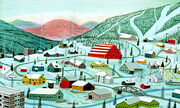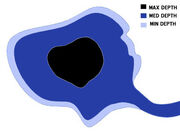A lot of details are available on the Map/Housing post, so check that out first. The expanded info is separated into sections for your convenience.
Distances and Travel Time

From the furthest corners of the map, Luceti is 190 miles from west to east, and 85 miles north to south. Since the barrier is oval-shaped, the distance from one end to another often varies. Travel time can also vary, so here is a scaled map of the area:
If you'd rather not work it out yourself, here's the time it takes to get around the area, on average. (Average being 3 miles per hour for 8 hours a day.)
- From the plaza to the northern edge of the barrier: 2 days or 50 miles
- From the plaza to the western edge: 2 days or 50 miles
- From the plaza to the southern edge: 1 day or 30 miles
- From the plaza to the red tunnel exit: 2 days or 60 miles
- From the edge of the mountain to the beach: 5 days or 60 miles (6 miles high + 50 miles wide = approx. 60 miles; travel time is lengthy due to the precarious climb, as the mountain is extremely difficult to scale without proper equipment)
- From the tunnel exit/mountain across the ocean to the eastern edge: 65 miles (no attempt to cross it has been made yet)
The village itself is only about 1 square mile overall; one can traverse the entire village in a few hours, and it only takes a few hours to reach the southern lake.
For those who can fly, they'll find that they can only reach a height of about 10 miles before they hit the top of the barrier. If you're inclined to try and dig under it, it runs about 30-40 feet deep, but... the Malnosso have ways of preventing that, so expect some interference there. It's been tried before.
Village

The village is a quiet little collection of sturdy but old-school farmhouses and brick apartment buildings. There are also a number of shops surrounding a plaza, run by either players or unnamed/unplayed NPCs. The village has a homey look to it, meant to be a close community rather than a vast city. It sort of resembles this:
There's a few buildings built by citizens scattered here and there, as well as shops within established buildings. Most of these should be labeled on the Map/Housing post, so if you happen to build something or decide you want to run a shop, be sure to let a mod know.
The houses have electricity, so they have lights, electric stoves, and an upgraded icebox. There is a fireplace to keep the houses warm when necessary, indoor plumbing, and a water heater. They all come fully furnished and remain that way whether they're occupied or not, but if characters want to switch out or get new furniture, they can find some at the item bazaar.
Self-Repairing
The houses, buildings and other elements of the environment are generally programmed to self-repair when extensive damage is incurred. If the characters take it upon themselves to repair damage, of course the "system" might not get around to it. Basically if a wall is torn down, it'll remain as such for a couple days until -quite suddenly- the wall will exist again. More extensive damage -like a house burning down- would take a little more time in that sections of the house will appear over the course of a few days or so until the building is once again as it was before destruction.
Any structures built by the residents of Luceti, however, are not repaired when damaged. The barracks are a good example of this; should anything happen to that building, it wouldn't be repaired by the system.
Forests
...THERE ARE TREES. The species sort of vary with no particular organization; there's evergreens mixed with deciduous, tiny saplings mixed with ancient giants. They are exceptionally fast-growing, with a tendency to sprout a few inches or feet in the dark or when no one is watching, though they don't grow to excessive sizes. It's quite remarkable, really - and lucky, considering how often Luceti is damaged by one disaster or another.
The forest is also populated by a variety of creatures; birds, mammals, insects, whatever's normal in a number of regions. Bears, foxes, wild boars, mosquitoes, raccoons, robins, fish... lots of critters to pick from. They're wild, but on the same level as animals that live around, say, a campsite; they usually stick to the woods, but see humans so often they're normally unimpressed and often bold, if not outright friendly and helpful. Don't mistake them for pets, though. That takes much more work.
Speaking of pets, characters can occasionally find strays around the village, somewhat tamed animals such as cats or dogs, and manage to convince them to follow them home. They're easier to tame than forest wildlife.
Mountain
The mountains on the eastern side of the village are tall, jagged, and awfully precarious to climb unless one has the proper equipment. The mountain is comprised of a number of different rock types, varying in age, strength, and hardness, and a determined person might be able to harvest metals and elements from it, if they look hard enough. There is also a series of caves, not necessarily all connected, but scattered across the entire mountainside. They vary in length and size, which offers players the freedom to explore with few restrictions. There might be some crystals in the caverns, too. Go nuts!
There is an empty Malnosso structure in the mountains, with the look of something that has been abandoned for a long time. There are several cells inside, with chains attached to the wall. In a large room towards the center of the building, there is a room with a few dusty tables and large, rusted machinery; a console that is built into a wall and a tank, large enough for a full grown man to fit inside. The console's monitor is empty and dead, and the electricity that once ran through the building is long gone, a rusted, busted generator locked up in a room deeper inside. While pieces of the more simple parts (gears, wires and the like) can be salvaged, anything computerized is too damaged to be used properly.
Lakes/Rivers
For each of the lakes, the temperature varies depending on season, but they're usually between 65-80 degrees F in spring and summer, and between 32-55 degrees F (0-13 C) for the rest of the year, colder when frozen.

The western lake.
The western lake is about 10 miles across; it takes several hours (on average) to walk the perimeter. The deepest point is approximately 50 feet, the average depth overall is 25-35 feet, with low depth for about 10-15 feet from the shore before the water level starts to drop. The shoreline has about five feet of sand-and-rock beach before the water starts, and there is a dock on the east side, close to where the river joins the lake. It's safe to dive off of, and there are several small cliff edges around the perimeter (ranging from 5-25 feet high) for cliff-diving.
This lake is totally frozen over (safe for skating and such) in approximately mid-December and is fully thawed by March.

The southern lake.
The southern lake is about 5 1/2 miles across; it takes an hour or two to walk the perimeter. The deepest point is 40 feet but the overall average is closer to 20 feet, with low depth for about 10 feet from the shore before the water level starts to drop. The shoreline has about twenty feet of sandy beach on the northern edge, and primarily rocky terrain around the remaining perimeter. There is a dock close to the lake house.
This lake is frozen over by the first week of December and thaws by February.
The size of the river running through Luceti varies depending on location, but typically the statistics are as follows: 10-15 feet wide, 5-8 feet deep. The river usually flows slowly and steadily through the village from the mountain source to the two lakes. Despite the fact that it only flows in one direction, the lakes never overflow, nor does the mountain spring drain.

Mountain lake
The mountain lake is about the same size of the southern lake, but there are no beaches; it's strictly surrounded by rocks, and it's not easy to get to by any means unless you know the route well enough. The lake is a great deal deeper than the others, however; unnaturally so. The center of the lake is seemingly bottomless. This lake never freezes over due to the depth and the proximity of the hot spring. It's usually a comfortable temperature regardless of season.
There is a hot spring located within half a mile of the mountain lake. It's not very well known; since it's primarily under the mountainside it stays out of sight and isn't often used due to its hard-to-reach location. The spring itself is soothing, warm, and clean at all times of the year, and the water has some curative properties. There is a small stream connecting the mountain lake to the hot spring.
Currently there is a teleporter that goes directly to the hot spring, and a bathhouse has been built.
Ocean
Beyond the mountain is a sandy beach for a mile or less; after that is a saltwater ocean that goes as far as the eye can see, well beyond the limits of the barrier. The ocean is fairly nondescript and self-explanatory at the moment; it's big, it's deep, it has some interesting ocean creatures, much like any other.
At the very edge of the ocean (before the barrier, that is), the former desert temple is now miles and miles under the surface. No doubt that it'll become an underwater castle for the fish before long.
More details will be added to this section as they become available.